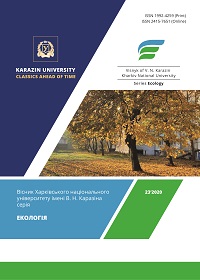Використання методик біотестування для оцінювання екологічного стану поверхневих вод
Анотація
Здійснено аналіз зарубіжних та вітчизняних джерел з питань використання методик біотестування для оцінювання екологічного стану поверхневих вод та визначення токсичних властивостей води і хімічних речовин. Обґрунтовано вибір оптимального набору методик біотестування для оцінювання екологічних наслідків хімічного забруднення поверхневих вод; дослідження системи екологічної відповідальності, яка діє в європейських та інших зарубіжних країнах, та національних нормативно-правових актів щодо стягнення збитків за порушення водного законодавства. У світовій практиці для отримання даних щодо впливу небезпечних хімічних речовин токсичної дії на водні екосистеми використовується метод біотестування. Біотести доступні і дешеві (при використанні спеціально опрацьованих для практичних потреб модифікацій), не вимагають спеціальної підготовки виконавців і легко можуть бути засвоєні в дослідних лабораторіях.
Для оцінки і контролю якості поверхневих вод та джерел їх забруднення відповідно до рекомендацій Водної Рамкової Директиви 2000/60/ЄС застосовуються методики біотестування з використанням «базового набору таксонів» – водоростей, ракоподібних та риб.
##submission.downloads##
Опубліковано
Номер
Розділ
Ліцензія
Авторське право (c) 2021 Крайнюкова А. М., Крайнюков О. М., Кривицька І. А.

Ця робота ліцензується відповідно до Creative Commons Attribution 4.0 International License.
Автори, які публікуються у цьому журналі, погоджуються з наступними умовами:
- Автори залишають за собою право на авторство своєї роботи та передають журналу право першої публікації цієї роботи на умовах ліцензії Creative Commons Attribution License 4.0 International (CC BY 4.0), котра дозволяє іншим особам вільно розповсюджувати опубліковану роботу з обов'язковим посиланням на авторів оригінальної роботи та першу публікацію роботи у цьому журналі.
- Автори мають право укладати самостійні додаткові угоди щодо неексклюзивного розповсюдження роботи у тому вигляді, в якому вона була опублікована цим журналом (наприклад, розміщувати роботу в електронному сховищі установи або публікувати у складі монографії), за умови збереження посилання на першу публікацію роботи у цьому журналі.
- Політика журналу дозволяє і заохочує розміщення авторами в мережі Інтернет (наприклад, у сховищах установ або на особистих веб-сайтах) рукопису роботи, як до подання цього рукопису до редакції, так і під час його редакційного опрацювання, оскільки це сприяє виникненню продуктивної наукової дискусії та позитивно позначається на оперативності та динаміці цитування опублікованої роботи (див. The Effect of Open Access).

